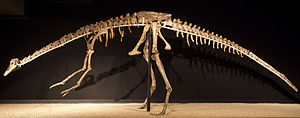Anserimimus
| Anserimimus | ||||||||||||
|---|---|---|---|---|---|---|---|---|---|---|---|---|

Skeletal reconstruction of Anserimimus |
||||||||||||
| Temporal occurrence | ||||||||||||
| Upper Cretaceous (early Maastrichtian ) | ||||||||||||
| 72 to 69.9 million years | ||||||||||||
| Locations | ||||||||||||
| Systematics | ||||||||||||
|
||||||||||||
| Scientific name | ||||||||||||
| Anserimimus | ||||||||||||
| Barsbold , 1988 | ||||||||||||
Anserimimus is a genus of dinosaurs from the group of Ornithomimosauria within the Theropoda . He lived in the late Upper Cretaceous in what is now East Asia.
features
From anserimimus only parts of the fuselage skeleton known so far. As far as is known, his body was largely similar to that of the other ornithomimosauria. It was a slender, lightly built dinosaur that moved biped on its hind legs. Presumably he could run fast thanks to his graceful legs and elongated lower legs and metatarsals . The arms were stronger than those of his relatives. The humerus had enlarged epicondyli (protruding bones that served as muscle attachment points) and the claws of the fingers were not bent and flattened on the underside. The skull is not yet known. What Anserimimus lived on is just as unclear as the function of the strong arms.
Discovery and naming
The fossil remains of Anserimimus were discovered in the Nemegt Formation in the Mongolian province of Bajanchongor-Aimag and first described in 1988 . The name means "geese imitator" and is part of the tradition that ornithomimosauria are often referred to as imitators ( mimus ) of various birds. The type and only known species is Anserimimus platinychus . The find is chronostratigraphically dated to the late Upper Cretaceous (early Maastrichtian ) and geochronologically to an age of 72 to 69 million years.
literature
- Peter J. Makovicky , Yoshitsugu Kobayashi, Philip J. Currie : Ornithomimosauria. In: David B. Weishampel , Peter Dodson , Halszka Osmólska (eds.): The Dinosauria . 2nd edition. University of California Press, Berkeley CA et al. 2004, ISBN 0-520-24209-2 , pp. 137-150.
Web links
Individual evidence
- ^ Gregory S. Paul : The Princeton Field Guide To Dinosaurs. Princeton University Press, Princeton NJ et al. 2010, ISBN 978-0-691-13720-9 , p. 113, online .